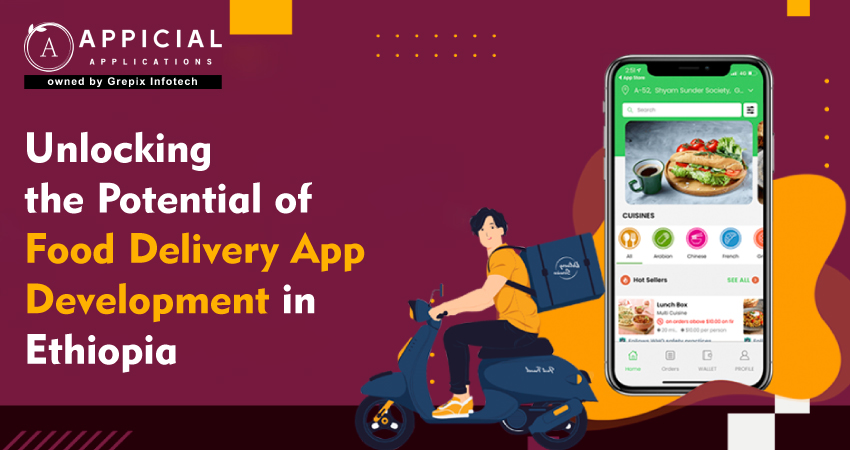
Unlocking the Potential of Food Delivery App Development in Ethiopia
At dawn in Addis Ababa, the city wakes up to noise and hope. Vendors roll carts onto the street. Delivery trucks rumble to life. Shops open their metal doors, ready for a day of sales.
But every day, goods arrive late. Deliveries miss their schedules. Fresh produce rots on the way to markets. Shops lose money. Customers lose trust. Time is lost for everyone.
Ethiopia's economy is growing rapidly, but food delivery has yet to catch up. Some companies continue to employ phone calls and accounting records to track deliveries.
Riders and drivers wait in traffic with no clear routing. Families order food, but they don’t know when it will arrive.
Food delivery app development in Ethiopia matters in 2025 because it is the key to fixing this. A well-designed restaurant app can help vendors cut waste, drivers deliver more quickly, and restaurants serve more patrons. On-time meal delivery benefits families, and small businesses can grow with confidence.
If you want to build an app that matters, now is the right time.
Ethiopia’s delivery system is ready for change. Long waits and delivery mix-ups slow down businesses every day. Customers lose trust when food arrives late or cold. Vendors lose money when orders get stuck. Food delivery app development in 2025 can fix this. It can speed up deliveries and give customers live updates. It can help local restaurants reach more people and reduce waste. Riders can find better routes and earn more in less time. This guide shows why food ordering apps, restaurant app solutions, and meal delivery tech matter in Ethiopia right now. It breaks down what you need to build a mobile app for food delivery that people trust and use daily. We also share how Appicial helps you build and launch your app without stress. We handle the tech while you focus on growing your business. Together, we can build a system that supports your business and your community.
Why Invest in Food Delivery App Development in Ethiopia?
Food delivery is one piece of a bigger story. People in Ethiopia are ready for services that save them time. Here are some on-demand apps that people use or want:
- Grocery delivery for families who can’t spare hours in traffic.
- Instant service apps to get essentials like medicine or urgent parcels.
- Food Delivery Apps that deliver food from cafes, restaurants, and neighborhood food vendors.
- Home Service App platforms for home services that link clients with electricians, plumbers, and cleaners.
- Taxi booking app solutions for safer, faster rides across the city.
- Handyman app platforms for quick fixes and installations at home.
These apps give people more time for family, studies, and work. They make daily life smoother, especially in busy cities.
What are the Core Features of an On-Demand App?
People don’t want complicated apps. They want apps that work.
If you’re building a food delivery app, focus on these essentials:
- Easy sign-up with phone numbers or social media.
- Simple navigation anyone can use.
- Language options, including Amharic.
- Reliable tracking so people know when food will arrive.
- Flexible payment, including cash and mobile money like Telebirr.
- Clear, real-time notifications about orders.
- Reviews and ratings to build trust.
- Reward points or discounts for loyal customers.
- Clean dashboards for restaurant partners to manage orders.
- A driver app that helps riders plan routes and see order details.
These features make life easier for customers, riders, and restaurants. They help your app earn trust and daily use.
What are the Benefits of On-Demand Apps for Local Startups?
Your food delivery app won’t just help your business grow. It will support your community.
- Job opportunities for riders: Underemployment and unemployment are major issues for a lot of young people. The flexible employment options offered by food delivery apps allow riders to select their own working hours and make money. It's a wise decision for college students who need to work around their classes or young people attempting to provide for their families while looking for a stable job. Every delivery generates income that can be applied to tuition, savings, or everyday costs.
- Informational insights: Your app can provide vendors and restaurants with useful insights. They discover the most popular meals, what people like to order, and when customers are most active. This enables them to modify their menus, improve inventory control, and make offers that customers genuinely want. Data becomes a tool for local businesses to use rather than speculating about what might sell.
- Trust in digital tools: A well-made food delivery app increases users' comfort level when utilizing technology for everyday tasks. Individuals are more inclined to employ other instant service apps, home service apps, taxi booking apps, and handyman app platforms once they see that an app can assist them in placing fast and dependable meal orders. By encouraging digital adoption and bolstering Ethiopia's larger tech ecosystem, this trust fosters the expansion of local startups.
Why Invest in Food Delivery App Development in Ethiopia?
Food delivery is not a luxury anymore. It’s a need.
Restaurants want to reach customers who can’t come in person. Workers and students want reliable meals during their busy days. Families want warm, fresh food without standing in line or sitting in traffic.
Food ordering apps bridge this gap. They connect restaurants to homes and offices. They create flexible work for riders who need income. They help restaurants maintain steady sales, even during slow hours.
When you invest in restaurant app solutions and meal delivery tech in Ethiopia, you create a ripple effect. You help local economies grow. You help reduce food waste. You help riders earn. You help customers save time.
In Ethiopia, where urban areas are expanding and digital adoption is rising, investing in a food delivery mobile app is a smart way to support your community while building a profitable business.
Which features are essential for a food delivery app?
If you want to make your app stand out, here are the features that you should include.
- Live order tracking so customers can see exactly where their food is.
- Optimized driver routing to save time and fuel.
- Easy payment methods, including cash, Telebirr, and cards.
- Clear order management so restaurants handle orders smoothly.
- Driver dashboards to let riders track deliveries and earnings.
- Customer ratings and feedback to build trust.
- Push notifications to keep customers informed without calling.
- GPS address pins for accurate delivery locations.
These features turn your food ordering apps into reliable tools people will use daily.
What is the Technology Stack and Architecture?
A great mobile app for food delivery needs a solid backbone. Here’s what works:
- Frontend: Flutter or React Native for a smooth, fast app on Android and iOS.
- Backend: Node.js or Laravel for scalable, clean performance.
- Database: MongoDB or PostgreSQL for reliable order and customer management.
- Real-time updates: Live delivery tracking is available via Socket.io.
- Maps: For precise routing, use OpenStreetMap or Google Maps API.
- Payments: Telebirr and other gateway integration.
- For scalability and stability, use AWS or DigitalOcean for cloud hosting.
What are the Challenges and Market Gaps in Ethiopia?
Building meal delivery tech in Ethiopia is worth it, but you need to know the realities on the ground.
- Traffic slows everything down: Drivers get stuck for hours, wasting fuel and missing delivery windows. Customers wait too long, and restaurants get complaints. Your app must offer smart routing to help riders avoid clogged roads.
- Internet connectivity can be unreliable: Drops in connection cause tracking issues and order delays. Riders lose direction mid-route. Customers lose visibility. Your app needs offline capabilities and low-data modes to keep working.
- Cash is still king: Many customers prefer cash on delivery. This slows transactions and puts riders at risk of carrying cash. Your app must handle cash workflows while encouraging digital payments like Telebirr.
- Poor road conditions hurt delivery speed: Bumpy roads damage vehicles and slow riders. Drivers lose money on repairs. Your app should help drivers mark hard-to-reach zones and adjust estimated delivery times.
- Restaurants lack insights into customer behavior: Many restaurants don’t know what items sell best or when peak orders happen. Your restaurant app solutions can gather and share useful data to help them improve.
- Address clarity is a real issue.: Many customers give unclear addresses, leading to wrong deliveries. Riders waste time calling for directions. In order to verify drop-off locations, your app should support GPS pins and in-app chat.
- Everyone is frustrated by a lack of communication.: Network problems cause calls to drop. Errors result from misunderstandings. To cut down on confusion, your app should have in-app messaging.
These present opportunities as well as significant challenges. You will create a brand that people will trust and recommend if your food ordering apps address these issues.
Also Read: How food delivery app development in Morocco is Reshaping Mealtime
Estimated Development Cost & Timeline
A strong meal delivery tech solution does not appear overnight. It takes focused effort:
- 1 month for a basic MVP to test your market.
- 1–3 months for a full-featured app with real-time tracking, payments, and advanced management.
Estimated costs:
- $12,000–$18,000 for MVP development.
- $20,000–$35,000 for a full, scalable version.
As you grow, you can add more features to your app after starting small and improving it based on user feedback.
How Appicial Applications Can Help?
Building a mobile app for food delivery in Ethiopia is a big step, but you don’t have to take it alone.
At Appicial Applications, we help founders and startups bring food ordering apps and restaurant app solutions to life. We understand the challenges of Ethiopia’s market. We have a team of dedicated app development experts who have 10+ years of experience in building lightweight, user-friendly apps that work well even with low connectivity.
We handle:
- Clean, intuitive UI/UX that customers and drivers understand.
- Real-time tracking that keeps customers informed.
- Payment integrations, including Telebirr.
- Scalable architecture to prevent crashes as you expand.
- Constant assistance to make your app better.
Your idea is important, and we have the know-how and resources to transform it into a useful app that makes money while benefiting your community.
Conclusion
Ethiopia’s delivery ecosystem needs better tools to keep up with its growth. Food delivery app development is not just a business opportunity; it’s a practical solution that helps people save time, reduce waste, and build trust in digital tools.
When you launch food ordering apps and meal delivery tech, you help a restaurant serve more people, a rider earn income, and a customer enjoy fresh food without stress.
If you’re ready to build a mobile app for food delivery that makes a difference, Appicial Applications is here to walk with you. Let’s create an app that improves deliveries in Ethiopia, one order at a time.
FAQs
Author's Bio

Vinay Jain is the Founder at Grepix Infotech and brings over 12 years of entrepreneurial experience. His focus revolves around software & business development and customer satisfaction.
Back to blog list




